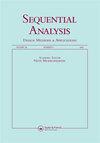等奇格事件概率的一个关键不等式的证明
IF 0.6
4区 数学
Q4 STATISTICS & PROBABILITY
Sequential Analysis-Design Methods and Applications
Pub Date : 2022-10-02
DOI:10.1080/07474946.2022.2129689
引用次数: 0
摘要
摘要Levin和Leu(2021)介绍了一些关键不等式,这些不等式是在使用序列子集选择程序的Levin-Robbins-Leu家族的自适应成员进行二元结果时格事件概率下界公式的基础。在等优势参数的特殊情况下,我们为每个自适应过程提供了关键不等式的严格证明。我们还进一步深入了解了为什么关键不等式适用于任意赔率参数,并为一个简单但不平凡的原型例子提供了在这种情况下的完整证明。上述出版物中的两个勘误表也在本文中进行了更正。本文章由计算机程序翻译,如有差异,请以英文原文为准。
Proof of a Key Inequality for Lattice Event Probabilities with Equal Odds
Abstract Levin and Leu (2021) introduced some key inequalities that underlie the lower bound formula for the probability of lattice events when using adaptive members of the Levin-Robbins-Leu family of sequential subset selection procedures for binary outcomes. Here we provide a rigorous proof of the key inequality for each adaptive procedure in the special case of equal odds parameters. We also provide some further insight into why the key inequality holds for arbitrary odds parameters and we present a complete proof in that case for a simple yet non-trivial prototype example. Two errata in the abovementioned publication are also corrected herein.
求助全文
通过发布文献求助,成功后即可免费获取论文全文。
去求助
来源期刊

Sequential Analysis-Design Methods and Applications
STATISTICS & PROBABILITY-
CiteScore
1.40
自引率
12.50%
发文量
20
期刊介绍:
The purpose of Sequential Analysis is to contribute to theoretical and applied aspects of sequential methodologies in all areas of statistical science. Published papers highlight the development of new and important sequential approaches.
Interdisciplinary articles that emphasize the methodology of practical value to applied researchers and statistical consultants are highly encouraged. Papers that cover contemporary areas of applications including animal abundance, bioequivalence, communication science, computer simulations, data mining, directional data, disease mapping, environmental sampling, genome, imaging, microarrays, networking, parallel processing, pest management, sonar detection, spatial statistics, tracking, and engineering are deemed especially important. Of particular value are expository review articles that critically synthesize broad-based statistical issues. Papers on case-studies are also considered. All papers are refereed.
 求助内容:
求助内容: 应助结果提醒方式:
应助结果提醒方式:


